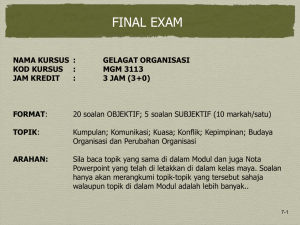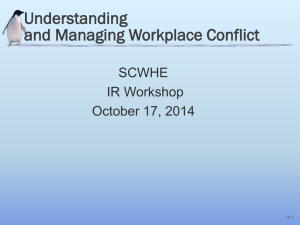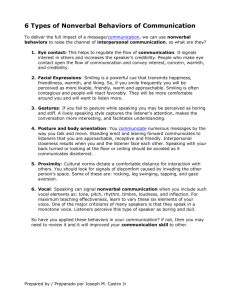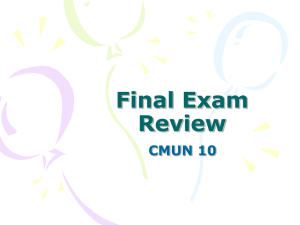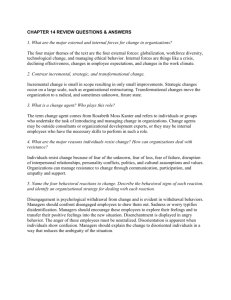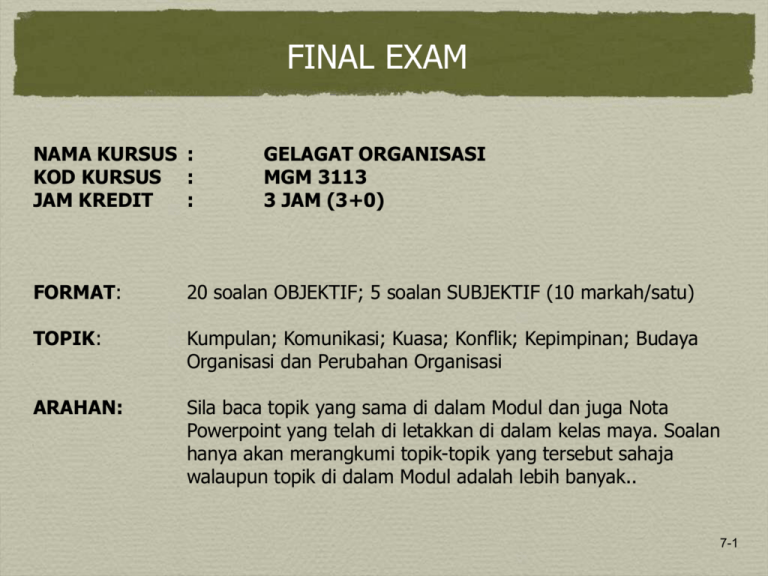
FINAL EXAM
NAMA KURSUS :
KOD KURSUS :
JAM KREDIT
:
GELAGAT ORGANISASI
MGM 3113
3 JAM (3+0)
FORMAT:
20 soalan OBJEKTIF; 5 soalan SUBJEKTIF (10 markah/satu)
TOPIK:
Kumpulan; Komunikasi; Kuasa; Konflik; Kepimpinan; Budaya
Organisasi dan Perubahan Organisasi
ARAHAN:
Sila baca topik yang sama di dalam Modul dan juga Nota
Powerpoint yang telah di letakkan di dalam kelas maya. Soalan
hanya akan merangkumi topik-topik yang tersebut sahaja
walaupun topik di dalam Modul adalah lebih banyak..
7-1
Team Dynamics
Chapter Seven
McGraw-Hill/Irwin
Copyright © 2009 by The McGraw-Hill Companies, Inc. All rights reserved.
What are Teams?
Groups of two or more people
Exist to fulfill a purpose
Interdependent -- interact and
influence each other
Mutually accountable for
achieving common goals
Perceive themselves as a social
entity
7-3
Groups versus Teams
All teams are groups
Some groups are just people assembled together
Teams have task interdependence whereas some
groups do not (e.g., group of employees enjoying
lunch together)
7-4
Many Types of Teams
•
Departmental teams
•
Skunkworks
•
Production/service/
leadership teams
•
Task force (project)
teams
•
Self-directed teams
•
Virtual teams
•
Advisory teams
•
Communities of practice
7-5
Why Informal Groups Exist
1.
Innate drive to bond
2.
Social identity
We define ourselves by group memberships
3.
Goal accomplishment
4.
Emotional support
7-6
Team Effectiveness Model
Team Design
•Task characteristics
•Team size
Organizational
•Team composition
and Team
Environment
Team Processes
•Team development
•Team norms
•Team cohesiveness
•Team trust
Team
Effectiveness
• Achieve
organizational
goals
• Satisfy member
needs
• Maintain team
survival
7-7
Team’s Task and Size
Task characteristics
Better when tasks are clear, easy to implement
Share common inputs, processes, or outcomes
Task interdependence
Team size
Smaller teams are better
But large enough to accomplish task
7-8
Levels of Task Interdependence
High
A
Reciprocal
B
Sequential
A
C
B
C
Resource
Pooled
Low
A
B
C
7-9
Team Development
Team development involves:
Interpersonal knowledge and trust
Understand and agree on roles
Discover appropriate behaviors
Learn to coordinate with each other
Develop team mental models
7-10
Stages of Team Development
Performing
Norming
Storming
Forming
Existing teams
might regress
back to an
earlier stage of
development
Adjourning
7-11
Team Norms
Informal rules and shared expectations team
establishes to regulate member behaviors
Norms develop through:
Initial team experiences
Critical events in team’s history
Experience/values members bring to the team
7-12
Team Cohesion
The degree of attraction people feel toward the
team and their motivation to remain members
Calculative -- members believe the team will fulfill
goals and needs
Emotional -- team is part of person’s social
identity
7-13
Influences on Team Cohesion
Member
similarity
Team
size
Member
interaction
• Similarity-attraction effect
• Some forms of diversity have less effect
• Smaller teams more cohesive
• Regular interaction increases cohesion
• Calls for tasks with high interdependence
7-14
Influences on Team Cohesion
Somewhat
difficult entry
Team
success
External
challenges
(con’t)
• Team eliteness increases cohesion
• But lower cohesion with severe initiation
• Successful teams fulfill member needs
• Success increases social identity with team
• Challenges increase cohesion when not
overwhelming
7-15
Constructive Conflict
Courtesy of Johnson Space Center/NASA
Occurs when team members debate their different
perceptions about an issue in a way that keeps the conflict
focused on the task rather than people.
Problem: constructive conflict easily slides into personal
attacks
7-16
Communication Defined
The process by which
information is transmitted
and understood between
two or more people
Transmitting the sender’s
intended meaning (not just
symbols) is the essence of
good communication
7-17
Importance of Communication
Coordinating work activities
Organizational learning
Decision making
Employee well-being
Fulfills the drive to bond
Self-concept through social
identity
7-18
Communication Process Model
Sender
Form
message
Transmit
Message
Encode
message
Receiver
Receive
encoded
message
Decode
message
Encode
feedback
Form
feedback
Noise
Decode
feedback
Receive
feedback
Transmit
Feedback
7-19
Problems with Email
Communicates emotions poorly
Reduces politeness and respect
Sending messages before
emotions subside (flaming)
Inefficient for ambiguous,
complex, novel situations
Increases information overload
Courtesy of Admiral Insurance
7-20
Nonverbal Communication
Actions, facial gestures, voice intonation, silence,
etc.
Transmits most info in face-to-face meetings
Influences meaning of verbal and written symbols
Less rule bound than verbal communication
Important part of emotional labor
Automatic and unconscious
7-21
Hierarchy of Media Richness
Rich
Overloaded
Zone
Media
Richness
Oversimplified
Zone
Lean
Routine/clear
Situation
Nonroutine/
Ambiguous
7-22
Communication Barriers
Perceptions
Selective attention
Difficulty empathizing with receiver
Filtering
Language
Jargon
Ambiguity
Information Overload
7-23
Cross-Cultural Communication
Verbal differences
Language
Nonverbal differences
Voice intonation
Interpreting nonverbal
meaning
Importance of verbal versus
nonverbal
Silence and conversational
overlaps
©Mark M. Lawrence/Corbis
7-24
Gender Communication Differences
Men
Report talk
Gives advice
quickly and directly
Conversations are
negotiations of status
Less sensitive to
nonverbal cues
Women
Rapport talk
Gives advice indirectly
and reluctantly
Conversations are
bonding events
More sensitive to
nonverbal cues
7-25
Active Listening Process & Strategies
Sensing
• Postpone evaluation
• Avoid interruptions
• Maintain interest
Active
Listening
Responding
Evaluation
• Show interest
• Clarify the message
• Empathize
• Organize information
7-26
The Meaning of Power
Power is the capacity of a
person, team, or organization
to influence others.
Craig Abraham/Fairfax Photos
Potential, not practice
People have power they don’t
use -- may not know they
possess
Power requires one person’s
perception of dependence on
another person
7-27
Power and Dependence
Person B’s
countervailing
power over
Person A
Person A
Person A’s control
of resource
valued by person
B
Resource
desired by
person B
Person B
Person A’s
power over
Person B
7-28
Model of Power in Organizations
Sources
of Power
Legitimate
Reward
Coercive
Expert
Referent
Power
over others
Contingencies
of Power
7-29
Contingencies of Power
Sources
of Power
Power
over others
Contingencies
of Power
Substitutability
Centrality
Discretion
Visibility
7-30
Increasing Nonsubstitutability
Increase control over the resource
Medicine -- exclusive right to perform medical
procedures
Labor unions -- control over skilled labor
Specialists -- exclusive knowledge how to operate or
repair equipment
Differentiate resource from others
Services provided by consulting firms
7-31
Centrality
Degree and nature of interdependence between
powerholder and others
Centrality is a function of:
How many others are affected by you
How quickly others are affected by you
7-32
Discretion and Visibility
Discretion
The freedom to exercise judgment
Rules limit discretion, limit power
Also a perception managers with internal locus of control
act like they have discretion
Visibility
Symbols communicate your power source(s)
—
—
Educational diplomas
Clothing etc (stethoscope around neck)
Salience
—
Location where others are more aware of your presence
7-33
Influencing Others
Influence is any behavior that attempts to alter
someone’s attitudes or behavior
Applies one or more power bases
Process through which people achieve organizational
objectives
Operates up, down, and across the organizational
hierarchy
7-34
Types of Influence
Silent
Authority
• Following requests without overt influence
• Based on legitimate power, role modeling
• Common in high power distance cultures
Assertiveness • Actively applying legitimate and coercive
power (“vocal authority”)
• Reminding, confronting, checking,
threatening
more
7-35
Types of Influence
(con’t)
Information
Control
• Manipulating others’ access to information
• Withholding, filtering, re-arranging
information
Coalition
Formation
• Group forms to gain more power than
individuals alone
1. Pools resources/power
2. Legitimizes the issue
3. Power through social identity
more
7-36
Types of Influence
Upward
Appeal
(con’t)
• Appealing to higher authority
• Includes appealing to firm’s goals
• Alliance or perceived alliance with higher
status person
Ingratiation/
Impress. Mgt.
• Ingratiation
• Impression Management
more
7-37
Types of Influence
Persuasion
Exchange
(con’t)
• Logic, facts, emotional appeals
• Depends on persuader, message content,
message medium, audience
• Promising or reminding of past benefits in
exchange for compliance
• Includes negotiation and networking
7-38
Consequences of Influence Tactics
Hard Influence
Tactics
Soft Influence
Tactics
Silent authority
Persuasion
Upward appeal
Coalition formation
Ingratiation &
impression mgt
Information control
Exchange
Assertiveness
Resistance
Compliance
Commitment
7-39
Organizational Politics
Behaviors that others perceive as selfserving tactics for personal gain at the
expense of other people and possibly
the organization.
7-40
Conditions for Organizational Politics
Tolerance of
Politics
Scarce
Resources
Conditions
Supporting
Organizational
Politics
Organizational
Change
Complex and
Ambiguous
Decisions
7-41
Conflict Defined
The process in which one party
perceives that its interests are being
opposed or negatively affected by
another party
7-42
Is Conflict Good or Bad?: Emerging View
Two types of conflict
Constructive (task) conflict
Conflict is aimed at issue, not parties
Produces benefits of conflict
Upper limit to any conflict, including constructive
Relationship (socioemotional) conflict
Aims conflict a the person (e.g. their competence), not
the task or issue
Introduces perceptual biases
Distorts information processing
7-43
Structural Sources of Conflict
Incompatible
Goals
• One party’s goals perceived to
interfere with other’s goals
Differentiation
• Different values/beliefs
• Explains cross-cultural and
generational conflict
Task
Interdependence
• Conflict increases with
interdependence
• Higher risk that parties interfere with
each other
more
7-44
Sources of Conflict (con’t)
Scarce
Resources
• Motivates competition for the resource
• Creates uncertainty, threatens goals
Ambiguous Rules • Without rules, people rely on politics
Communication
Problems
• Increases stereotyping
• Reduces motivation to communicate
• Escalates conflict when arrogant
7-45
Interpersonal Conflict Handling Styles
Forcing
Assertiveness
High
Problem-solving
Compromising
Avoiding
Low
Yielding
Cooperativeness
High
7-46
Leadership Defined
Leadership is the ability
to influence, motivate,
and enable others to
contribute toward the
effectiveness of the
organizations of which
they are members
7-47
Perspectives of Leadership
Competency
Perspective
Implicit
Leadership
Perspective
Leadership
Perspectives
Transformational
Perspective
Behavior
Perspective
Contingency
Perspective
7-48
Seven Leadership Competencies
Emotional
Intelligence
Integrity
Drive
Leadership
Motivation
• Perceiving, assimilating, understanding,
and regulating emotions
• Truthfulness
• Translates words into deeds
• Inner motivation to pursue goals
• Need for achievement, quest to learn
• High need for socialized power to
accomplish team’s or firm’s goals
more
7-49
Seven Leadership Competencies (con’t)
Self-Confidence
• Strong belief in one’s ability to lead
others
Intelligence
• Above average cognitive ability
• Can analyze problems/opportunities
Knowledge of
the Business
• Familiar with business environment
• Aids intuitive decision making
7-50
Leader Behavior Perspective
People-oriented behaviors
Showing mutual trust and respect
Concern for employee needs
Looks out for employee well-being
Task-oriented behaviors
Assign specific tasks
Ensure employees follow rules
Set “stretch goals” to achieve performance capacity
7-51
Path-Goal Leadership Styles
Directive
Task-oriented behaviors
Supportive
People-oriented behaviors
Participative
Encouraging employee involvement
Achievement-oriented
Using goal setting and positive self-fulfilling
prophecy
7-52
Path-Goal Leadership Model
Employee
Contingencies
Leader
Behaviors
Leader
Effectiveness
• Directive
• Employee
motivation
• Supportive
• Employee
satisfaction
• Participative
• Achievementoriented
• Acceptance of
leader
Environmental
Contingencies
7-53
Path-Goal Contingencies
Employee
Contingencies
Directive Supportive Participative Achievement
Skill/Experience
low
low
high
high
Locus of Control
external
external
internal
internal
Environmental
Contingencies
Directive Supportive Participative Achievement
Task Structure
nonroutine
routine
nonroutine
?
Team Dynamics
–ve norms
low cohesion
+ve norms
?
7-54
Leadership Substitutes
Contingencies that limit a leader’s influence or make a particular
leadership style unnecessary.
Examples:
Training and experience replace task-oriented leadership
Cohesive team replaces supportive leadership
Self-leadership replaces achievement-oriented leadership
Research evidence: substitutes help, but don’t completely
substitute for real leadership
7-55
Transformational v. Transactional Leaders
Transformational leaders
Leading -- changing the
organization to fit
environment
Change agents
Transactional leaders
Managing -- linking job
performance to rewards
Ensure employees have
necessary resources
Apply contingency leadership
7-56
Transformational v. Charismatic Leaders
Is charismatic leadership
essential for transformational
leadership?
Some experts say yes, but
emerging view is that:
Charisma is distinct from
transformational leadership
A personal trait that might help
transform, or might just help the
leader
Charismatic leadership might have
opposite effect -- creates
dependence, not empowerment
7-57
Transformational Leadership Elements
1. Create a strategic vision
Vision
—
—
Depiction of company’s (or work units) attractive future
motivates and bonds employees
May originate from others, but leader becomes a
champion of the vision
2. Communicate the vision
Frame message around a grand purpose
Create a shared mental model of the future
Use symbols, metaphors, symbols
7-58
Transformational Leadership Elements
3.
Model the vision
4.
(con’t)
Walk the talk
Symbolize and demonstrate the vision through their own
behavior
Builds employee trust in the leader
Build commitment to the vision
Increased through communicating and modeling the
vision
Increased through employee involvement in shaping the
shared vision
7-59
Organizational Culture Defined
The basic pattern of
shared values and
assumptions governing the
way employees within an
organization think about
and act on problems and
opportunities.
7-60
Elements of Organizational Culture
Artifacts
•
•
•
•
Stories/legends
Rituals/ceremonies
Organizational language
Physical structures/décor
Visible
Shared values
• Conscious beliefs
• Evaluate what is good or bad, right or
wrong
Invisible
(below the surface)
Shared assumptions
• Unconscious, taken-for-granted
perceptions or beliefs
• Mental models of ideals
7-61
Strengthening Organizational Culture
7-62
Organizational Socialization Defined
The process by which individuals learn the values, expected
behaviors, and social knowledge necessary to assume their roles
in the organization.
7-63
Stages of Socialization
Pre-Employment
Stage
Encounter
Stage
Role
Management
• Outsider
• Newcomer
• Insider
• Gathering
information
• Testing
expectations
• Changing roles
and behavior
• Forming
psychological
contract
• Resolving
conflicts
7-64
FBI Overcomes Resistance to Change
FBI staff resisted changing from
a reactive law enforcement
agency to a proactive domestic
intelligence agency.
Change is now occurring at the
FBI through extensive
communication, training, and
realignment of systems and
structures.
7-65
Lewin’s Force Field Analysis Model
A systems perspective of change
developed by social psychologist Kurt
Lewin
Restraining
Forces
Unfreezing and refreezing
Occur by altering driving and restraining
forces
Generate urgency to change
Address sources of resistance
New systems/structures refreeze desired
conditions
Driving
Forces
7-66
Force Field Analysis Model
Restraining
Forces
Desired
Conditions
Restraining
Forces
Restraining
Forces
Driving
Forces
Driving
Forces
Current
Conditions
Driving
Forces
Before
Change
During
Change
After
Change
7-67
Sources of Resistance to Change
Direct costs
Losing something of value due to
change
FBI’s new intelligence mandate
would reduce status in law
enforcement
Saving face
Accepting change acknowledges
own imperfection, past
wrongdoing
New FBI mandate acknowledges
value of CIA work (source of past
turf wars)
7-68
Sources of Resistance to Change
(con’t)
Fear of the unknown
Risk of personal loss
Concern about being unable to
adjust
Breaking routines
Organizational unlearning is part of
change process
But past practices/habits are
valued by employees due to
comfort, low cognitive effort
7-69
Sources of Resistance to Change
(con’t)
Incongruent organizational
systems
Systems/structures reinforce
status quo
FBI career, reward, power,
communication systems
supported law enforcement, not
intelligence
Incongruent team dynamics
Norms contrary to desired
change
7-70
Minimizing Resistance to Change
Communication
Highest priority and first strategy
for change
Improves urgency to change
Reduces uncertainty (fear of
unknown)
Problems -- time consuming and
costly
7-71
Minimizing Resistance to Change
Communication
Learning
Provides new knowledge and
skills
Includes coaching and action
learning
Helps break old routines and
adopt new roles
Problems -- potentially time
consuming and costly
7-72
Minimizing Resistance to Change
Communication
Learning
Employee
Involvement
Increases ownership of change
Helps saving face and reducing
fear of unknown
Includes task forces, future
search events
Problems -- time-consuming,
potential conflict
7-73
Minimizing Resistance to Change
Communication
Learning
Employee
Involvement
Stress
Management
When communication, training, and
involvement do not resolve stress
Potential benefits
More motivation to change
Less fear of unknown
Fewer direct costs
Problems -- time-consuming,
expensive, doesn’t help everyone
7-74
Minimizing Resistance to Change
Communication
Learning
Employee
Involvement
Stress
Management
Negotiation
When people clearly lose
something and won’t otherwise
support change
Influence by exchange-- reduces
direct costs
Problems
• Expensive
• Gains compliance, not
commitment
7-75
Minimizing Resistance to Change
Communication
Learning
Employee
Involvement
Stress
Management
Negotiation
When all else fails
Assertive influence
Firing people -- radical form of
“unlearning”
Problems
• Reduces trust
• May create more subtle
resistance
Coercion
7-76

